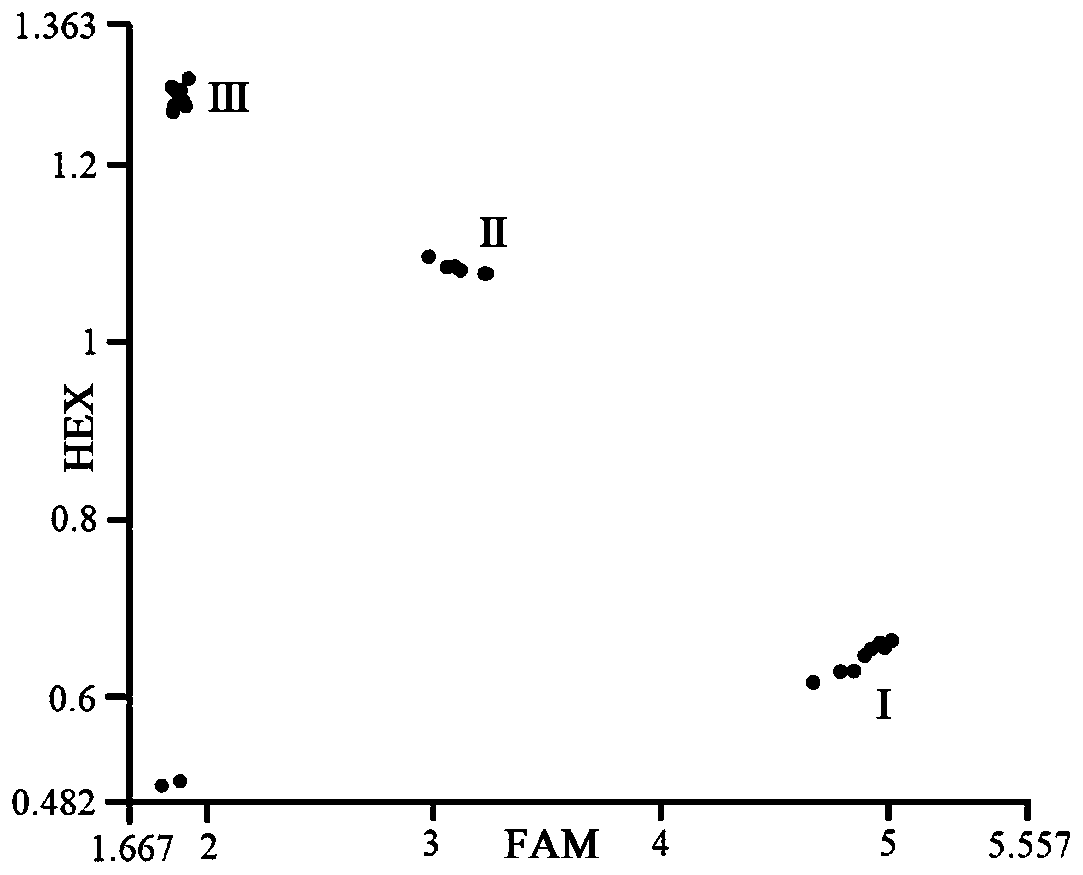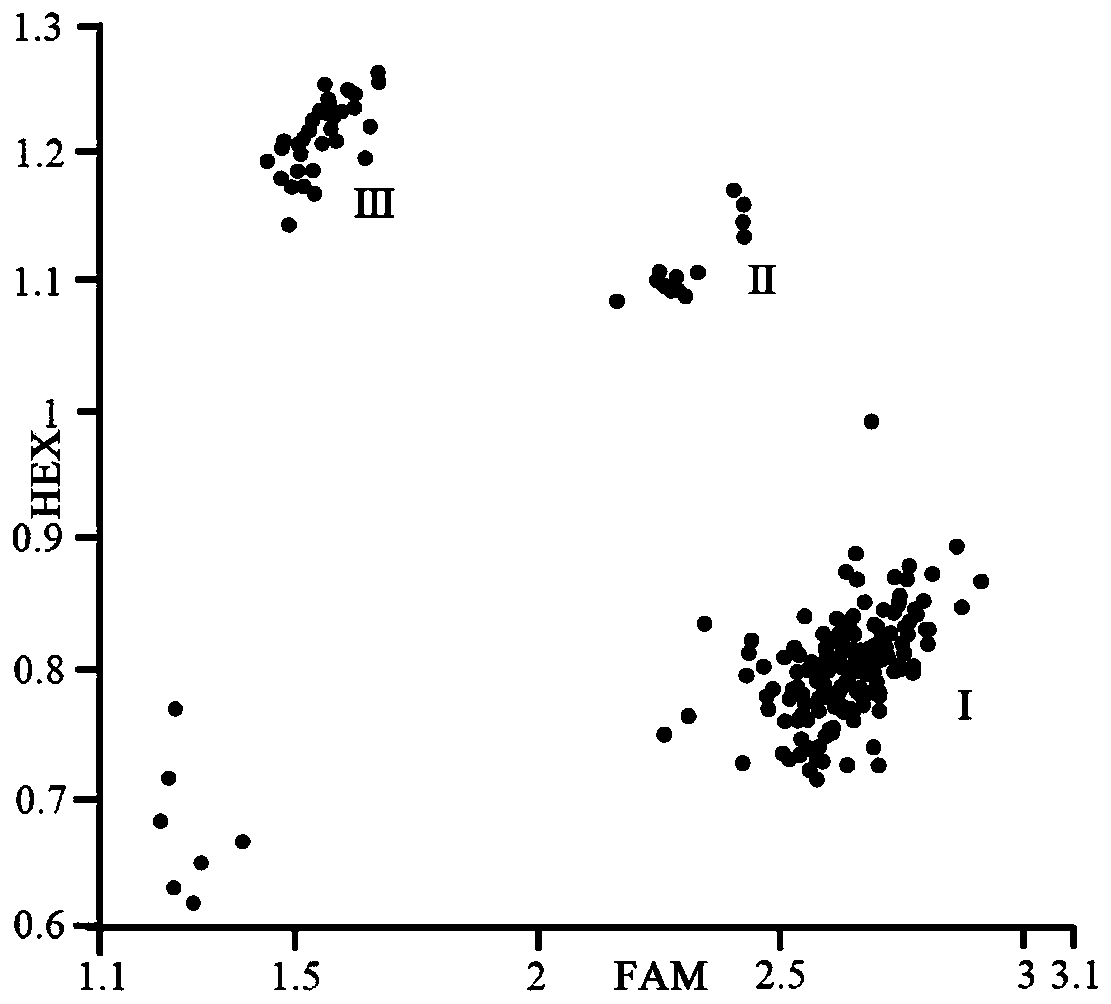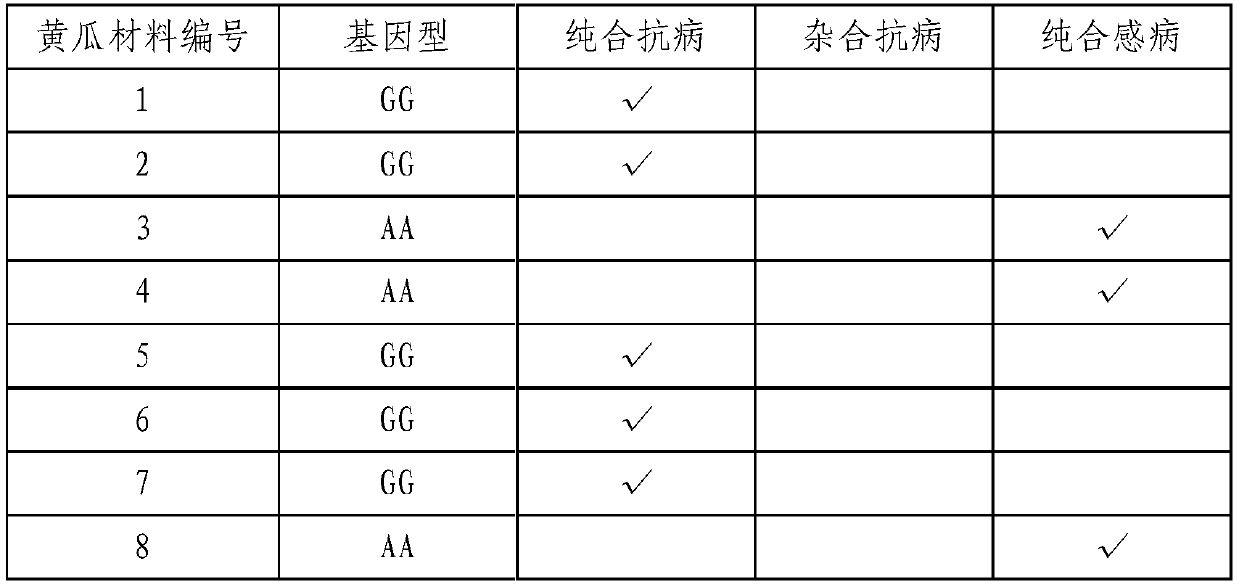KASP primers for detecting cucumber bacterial angular leaf spot gene of and application thereof
A technology for bacterial and angular spot disease, which is applied in the fields of molecular biology and crop breeding, can solve the problems of inability to determine the resistance of cucumber bacterial angular spot, long time-consuming, low accuracy of fluorescence detection, etc., to achieve accurate anti-corrosion Disease identification, speed up the breeding process, and improve the effect of breeding efficiency
- Summary
- Abstract
- Description
- Claims
- Application Information
AI Technical Summary
Problems solved by technology
Method used
Image
Examples
Embodiment 1
[0076] KASP mark development
[0077] Comparative analysis of the sequences of the two alleles of CsPSL and CsPSL323. Among them, CsPSL is a non-resistant allele, and CsPSL323 is a resistant allele, and there is a SNP locus at the position of 323bp between the two.
[0078] The SNP sites that can be used for the development of KASP markers must meet the following requirements: CsPSL and CsPSL323 have different genotypes; there are no other SNP sites nearby, and they are located in non-SNP dense regions; avoid continuous AT, high GC content and other complex sequences.
[0079] Therefore, the A / G locus at position 323 is the only selection target; the genotype of CsPSL in this locus is A, and the genotype of CsPSL323 is G.
[0080] Design primers for the above-mentioned sites, and their sequence is (wherein the underlined sequence is the added tag sequence):
[0081] No. 323 A / G:
[0082] Forward primer 1: 5’-GAAGGTGACCAAGTTCATGCTCAAGGATGGTATAATTGGCTTCA-3’;
[0083] Forward primer 2: 5'-G...
Embodiment 2
[0087] Amplification of molecular markers
[0088] The materials used in this example are the known anti-bacterial angular leaf spot material GY14 of cucumber and the material 9930 susceptible to bacterial angular leaf spot of cucumber.
[0089] The genomic DNA from cucumber leaves was extracted by alkaline boiling method, and the concentration of the extracted DNA solution was 10-50ng / μl and stored at -20°C.
[0090] Use KASP-PARMS kit (Jing peptide biological company) to configure the PCR reaction system, the total reaction volume is 10μl, including: 2X PARMS PCR Mix, 5μl; DNA extraction solution (10-50ng / μl), 1μl; forward primer CsPSL- F1, 0.15μl (10pmol / μl); forward primer CsPSL-F2, 0.15μl (10pmol / μl); reverse primer CsPSL-R, 0.4μl (10pmol / μl); and ddH2O, 4.3μl. Set three technical repetitions.
[0091] The PCR reaction program is: 94°C for 15 minutes; 94°C for 20 seconds, 65°C (decreased by 0.8°C per cycle) for 1 minute, 10 cycles; 94°C for 20 seconds, 57°C for 1 minute, 28 cycl...
Embodiment 3
[0093] Detection and analysis of amplified products
[0094] Use Tecan Infinite M200 multifunctional microplate reader to genotype PCR products, use SNPDecoder online data analysis software (http: / / www.snpway.com / snpdecoder / ) to analyze the data, and set the FAM fluorescence signal close to On the horizontal axis, the HEX fluorescence signal is close to the vertical axis.
[0095] See the results of marker typing figure 1 . In the figure, the horizontal and vertical coordinates indicate the signal value; the dot I is the amplified signal of the susceptible material 9930 (only FAM fluorescent signal is detected); the dot III is the amplified signal of the disease-resistant material GY14 (only the HEX is detected) Fluorescence signal); The dot at Ⅱ is the hybrid disease-resistant material GY14-9930-F1, and HEX fluorescence and FAM fluorescence are detected at the same time; the gray dot near the origin represents the amplification signal of the negative control (no DNA sample added)...
PUM
 Login to View More
Login to View More Abstract
Description
Claims
Application Information
 Login to View More
Login to View More - R&D
- Intellectual Property
- Life Sciences
- Materials
- Tech Scout
- Unparalleled Data Quality
- Higher Quality Content
- 60% Fewer Hallucinations
Browse by: Latest US Patents, China's latest patents, Technical Efficacy Thesaurus, Application Domain, Technology Topic, Popular Technical Reports.
© 2025 PatSnap. All rights reserved.Legal|Privacy policy|Modern Slavery Act Transparency Statement|Sitemap|About US| Contact US: help@patsnap.com



